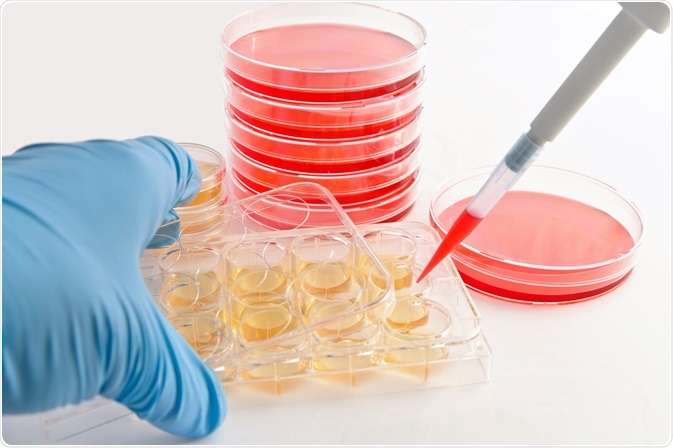What is a cell line?
A cell line is where a certain cell type is permanently cultured in vitro to continuously produce cells, as long as they are provided with fresh media on which to grow.
 Image Credits: Jens Goepfert / Shutterstock.com
Image Credits: Jens Goepfert / Shutterstock.com
A cell line is different from normal cell culture because the cells within a cell line have been immortalized. Cell immortalization is where the cells in a cell line are mutated in a way that makes them continually divide and not reach a certain limit of growth. Cells within a primary cell culture, on the other hand, are sampled directly from tissue and have a set life span.
Advantages of a cell line compared to primary cell culture:
- Provide an unlimited supply of cellular material for study
- Always produce the same purity of cells so results are reproducible
- Cost-effective
- Easy to maintain
Why do we need cell lines?
Setting up a cell line is an extremely common practice within the cellular and molecular biology research. These cells can be used to study a multitude of different areas of cellular metabolism and gene function, as well as being used to manufacture vaccines, antibodies, and certain drugs.
Different cell lines are used for specific purposes. For example, HeLa cell lines are commonly used to study cancer, Human Embryonic Kidney (HEK) cells are often used to study gene expression, and Chinese Hamster Ovarian (CHO) cells are frequently used for genetic engineering or for the synthesis of specific products.
What can reporter-labeled cell lines offer?
Reporter-labeled cell lines, also simply called reporter cell lines, offer different applications compared to a normal cell line. They can be used to visualize and track the expression of proteins, transcription factors, or other molecules as well as potentially track where they are within whole cells in real-time. This allows researchers to ensure that their cell lines are accurately representing the normal metabolic changes that occur within natural tissues and more importantly can determine which genes are being actively expressed within a cell.
How do reporter-labeled cell lines work?
The most common aim of a reporter cell line is to measure the expression of certain genes, or for the production of certain proteins. This is done through the introduction of reporter genes into a cell line.
Various genes can be used as reporter genes, and are normally chosen based on the extent of measurable activity. For example, the gene for luciferase or GFP (green fluorescent protein) is often used, as both proteins produced can be triggered to produce measurable fluorescence. This fluorescence can be measured with either a luminometer or a spectrophotometer.
The chosen reporter gene is inserted into a vector, next to a specific gene promoter that is being studied, and the cell line being used is then transfected with this vector. If the promoter is being actively expressed within the cell line, then the reporter gene will be expressed, which can be measured.
How can this system be utilized?
This system is mainly based on measuring whether specific promoters are being expressed, but this can be used to measure the activity of various biochemical pathways that have downstream signals that end with the transcription of genes. Determining whether certain genes are being expressed can also determine whether a cell line has been infected with a virus, or suggest the development of cancer.
This system is therefore very useful in the study of different diseases, as it produces easily interpretable results for how different genes are expressed under different conditions.
Sources
Gervaix, A., et al. (1997). A new reporter cell line to monitor HIV infection and drug susceptibility in vitro. Proceedings of the National Academy of Sciences. https://doi.org/10.1073/pnas.94.9.4653
Kaur, G., & Dufour, J. M. (2012). Cell lines: Valuable tools or useless artifacts. Spermatogenesis. https://doi.org/10.4161/spmg.19885
Richards, B., et al. (1999). Creation of a stable human reporter cell line suitable for FACS-based, transdominant genetic selection. Somatic cell and molecular genetics. https://doi.org/10.1023/a:1019206625658
Wang, G. Q., et al. (2006). Generation of a reporter cell line for detection of infectious varicella-zoster virus and its application to antiviral studies. Antimicrobial agents and chemotherapy. https://doi.org/10.1128/AAC.00342-06
Further Reading